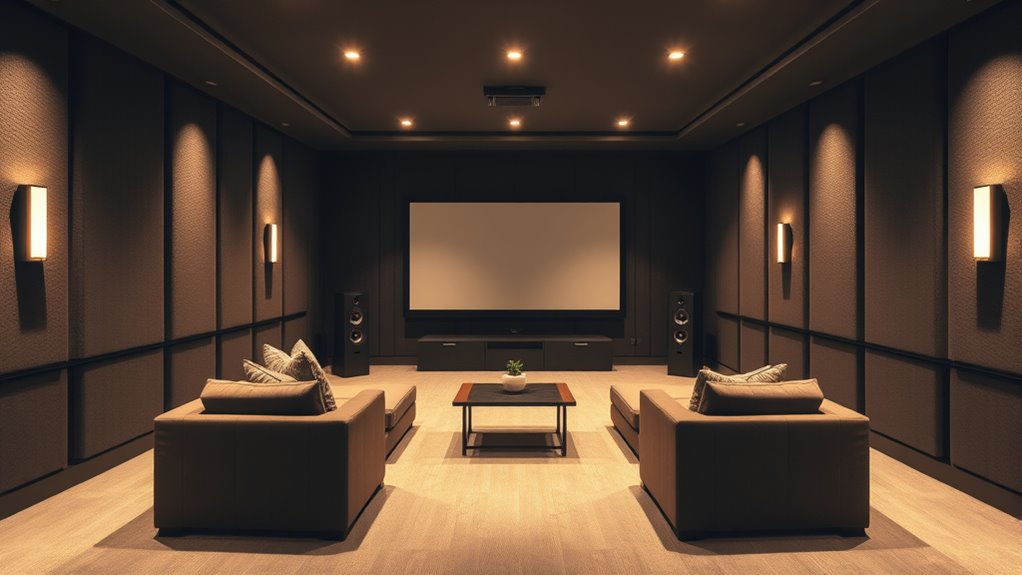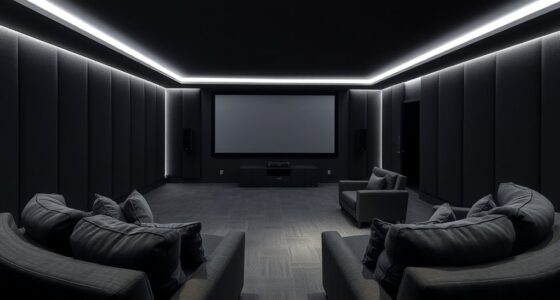For the best home theater sound, aim for a room that’s between 12 and 20 feet long, with a width about 1.5 to 2 times the length, and at least 8 feet high. Avoid overly small or long narrow spaces that cause sound issues. Use balanced proportions and consider adding acoustic treatments like panels and diffusers to improve clarity. Proper room shape and layout will keep sound clear and immersive—if you want to know how to optimize yours further, keep going.
Key Takeaways
- Choose a room length of 12-20 feet and width 1.5-2 times the length to optimize sound and viewing quality.
- Opt for rectangular rooms with balanced proportions to prevent standing waves and flutter echoes.
- Avoid overly narrow or elongated spaces; irregular shapes or angled surfaces help scatter sound waves.
- Incorporate acoustic treatments like panels and bass traps to control reflections and improve sound clarity.
- Position seating facing the speakers, away from walls and corners, to ensure uniform sound distribution.

Creating the perfect home theater starts with choosing the right room dimensions and shape. The size and layout of your space directly influence sound quality and viewing comfort. A well-designed room minimizes bad acoustics, which can distort audio and diminish your viewing experience. When considering dimensions, aim for a room that’s neither too small nor too large. Ideally, the room should be roughly 12 to 20 feet long, with a width that’s about 1.5 to 2 times the length. This proportion helps prevent sound waves from bouncing excessively, which can create echoes or dead spots. A room with a ceiling height of at least 8 feet offers enough space for sound absorption and proper speaker placement, reducing the risk of sound reflections that cause muddiness. Additionally, incorporating room proportions based on acoustic principles can further enhance sound clarity.
The shape of your room is equally critical. Rectangular rooms are common, but their dimensions should avoid ratios that lead to standing waves or flutter echoes. For example, avoiding ratios like 1:2 or 1:1.5 can help minimize these issues. Instead, aim for a room shape that promotes even sound distribution. If you have the flexibility, incorporating slight asymmetries or angled surfaces can help scatter sound waves more effectively, preventing focused reflections that muddy audio. Be cautious of overly long or narrow spaces, as these can cause sound to drift or echo, making dialogue hard to understand or music less clear.
Acoustic treatment plays an essential role in shaping the sound within your theater. Once you’ve chosen the right dimensions and shape, adding acoustic panels, bass traps, and diffusers will help control reflections and echoes. These treatments absorb or scatter sound waves, ensuring cleaner audio and more accurate sound imaging. Proper acoustic treatment complements your room’s shape, preventing sound from bouncing uncontrollably and creating a more immersive experience.
Your seating arrangement also impacts acoustics. Position seats to face the primary sound source, ideally centered in the room at an ideal distance from speakers and screens. Avoid placing seats too close to walls or corners, where sound waves tend to bounce and cause uneven audio. Elevate seating slightly if possible, so everyone has a clear view and audio isn’t obstructed. Combining a thoughtful seating plan with acoustic treatment ensures every seat provides a superb listening experience.
Frequently Asked Questions
How Does Room Height Affect Sound Quality?
Your room height considerably impacts sound quality by influencing ceiling acoustics and sound reflection. Higher ceilings reduce sound reflection issues, creating a more immersive experience, while lower ceilings can cause sound to bounce excessively, leading to echo and muddiness. Properly considering ceiling height helps you manage sound reflection, ensuring clearer audio and better overall acoustics. Aim for an ideal height that balances space and acoustic performance for the best home theater experience.
Can Irregular Room Shapes Improve Acoustics?
Imagine a room shaped like a giant amoeba, twisting and turning unpredictably. Irregular shapes can actually boost acoustics by scattering sound waves, reducing echoes and dead spots. This chaos creates a more immersive experience, with sound bouncing unpredictably and filling the space evenly. So, yes, irregular shapes offer acoustic benefits, turning your home theater into a sound-rich playground where audio feels alive and dynamic.
What Materials Best Absorb Sound in a Theater?
You should use soundproof curtains and acoustic wall panels to absorb sound effectively in your theater. Soundproof curtains block external noise and reduce echo, while acoustic wall panels absorb sound waves, preventing reverberation. Combining these materials creates a balanced environment with clear audio quality and minimizes unwanted noise. This setup guarantees an immersive experience, keeping sound within the room and enhancing your home theater’s overall acoustics.
How Important Are Door and Window Placements?
In the grand scheme of your home theater setup, door placement and window positioning are vital. You want doors located strategically to minimize sound leakage and avoid disrupting acoustics, while windows should be positioned to prevent external noise from infiltrating. Think of your room as a vintage radio, where proper placement of openings ensures the sound is crisp, immersive, and free from unwanted interference, elevating your viewing experience.
Should I Consider Room Symmetry for Better Acoustics?
Yes, you should consider room symmetry for better acoustics. Symmetrical rooms help create acoustic balance by evenly distributing sound waves, reducing echoes and dead spots. When your room has balanced dimensions and similar placement of speakers and seating, sound quality improves. Avoid asymmetrical layouts, as they can cause uneven sound distribution, making your home theater experience less immersive. Prioritize symmetry for clearer, more natural audio.
Conclusion
By choosing the right room dimensions and shape, you’ll create a home theater where sound complements the visuals, making every movie an immersive experience. Remember, avoiding common pitfalls is key—think of it as steering clear of the Titanic’s iceberg. With thoughtful planning, you’ll craft a space that feels timeless, like a classic film, and guarantees your audio-visual adventures remain unforgettable for years to come.









